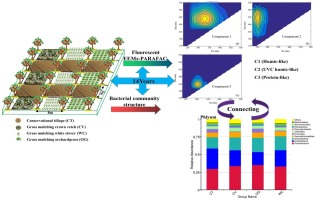Industrial Crops and Products ( IF 5.9 ) Pub Date : 2020-03-18 , DOI: 10.1016/j.indcrop.2020.112344 Jianfeng Yang , Yumin Duan , Rongqin Zhang , Chen Liu , Yuanji Wang , Ming Li , Yuanyuan Ding , Mukesh Kumar Awasthi , Huike Li

|
This study aims to clarify the relationship between soil dissolved organic matter (DOM) components and bacterial communities in long-term grass mulching management apple orchards (Malus domestica). The key role of the transformation of DOM components and soil nutrient cycling in improving orchard grass mulching management strategies was assessed. Four treatments, including legumes, such as white clover (WC) and crown vetch (CV); Gramineae orchardgrass (OG); and conventional tillage (CT) as the control, were employed to explore DOM components, the bacterial community structure and their relationship. In all the management systems, the DOM identified included two humic-like components and one protein component. The protein component was dominant in leguminous mulching (43.04–77.13 %), whereas the humic-like component was dominant in graminaceous mulching (42.17–72.11 %). Component 2 accounted for less than 1% in CT, CV and WC. The three types of grass mulching increased the proportion of copiotrophic bacteria and reduced that of oligotrophic bacteria, especially Proteobacteria (34.27–28.83%) and Acidobacteria (20.96–28.42%) at the phylum level. Legumes were beneficial for DOM transformation, and Gramineae species improved soil nutrition and bacterial communities. In conclusion, mulching of different grasses in orchards significantly changes the soil DOM components and bacterial community structure through different types of organic inputs, and the connection of these communities is closely coordinated with significant effects on soil nutrient cycling and orchard grass mulching strategies.
中文翻译:

将长期覆盖苹果园的土壤可溶性有机物与土壤细菌群落结构联系起来
这项研究的目的是阐明溶解有机物(DOM)在长期草成分和细菌群落地膜覆盖管理苹果园土壤之间的关系(海棠斯蒂卡)。评估了DOM成分的转化和土壤养分循环在改善果园草覆盖管理策略中的关键作用。包括豆科植物在内的四种处理方法,例如白三叶草(WC)和皇冠crown子(CV);禾本科果园(OG); 并以常规耕作(CT)为对照,研究了DOM成分,细菌群落结构及其相互关系。在所有管理系统中,确定的DOM包括两个腐殖质样成分和一个蛋白质成分。豆科覆盖物中蛋白质成分占主导(43.04–77.13%),而豆科覆盖物中腐殖质样成分占主导(42.17–72.11%)。成分2在CT,CV和WC中所占比例不到1%。门上的变形杆菌(34.27–28.83%)和酸性细菌(20.96–28.42%)。豆科植物有益于DOM的转化,禾本科物种改善了土壤营养和细菌群落。综上所述,果园中不同草的覆盖通过不同类型的有机输入显着改变了土壤DOM成分和细菌群落结构,并且这些群落之间的联系密切相关,对土壤养分循环和果园草覆盖策略具有重大影响。



























 京公网安备 11010802027423号
京公网安备 11010802027423号